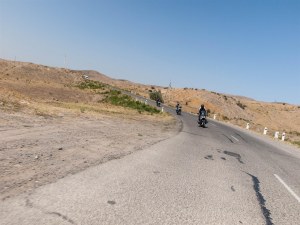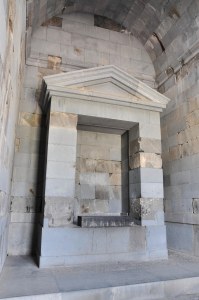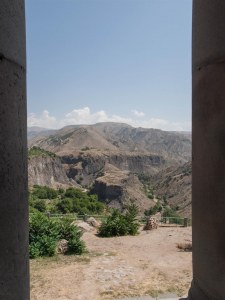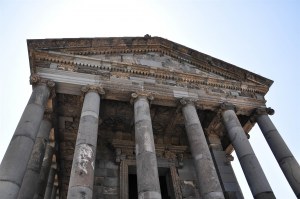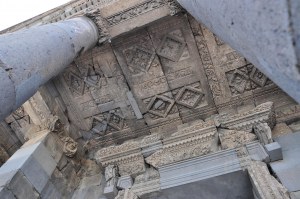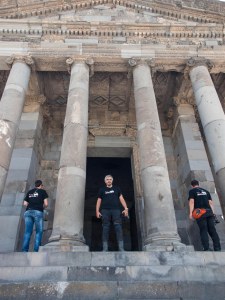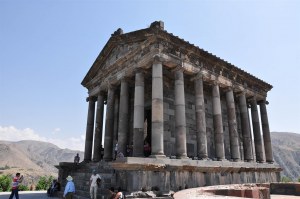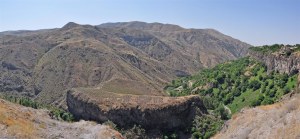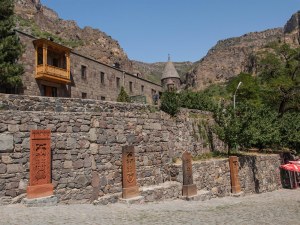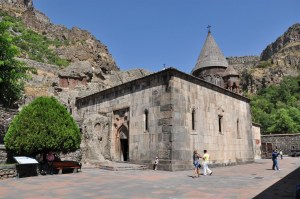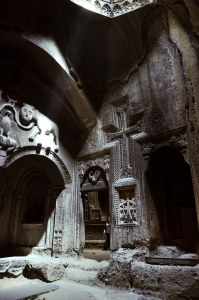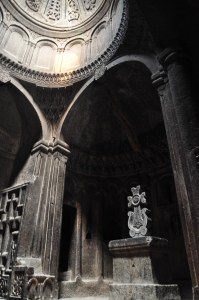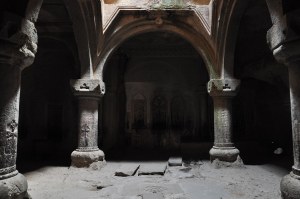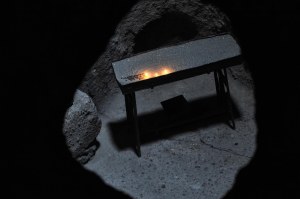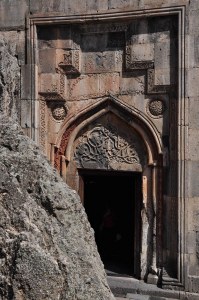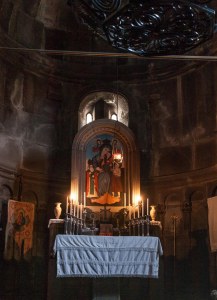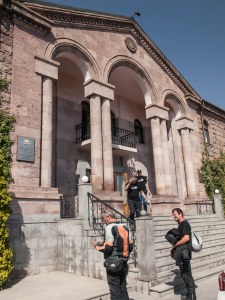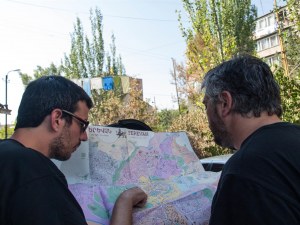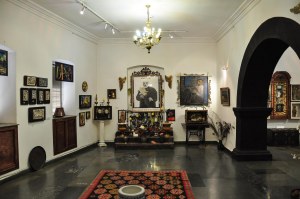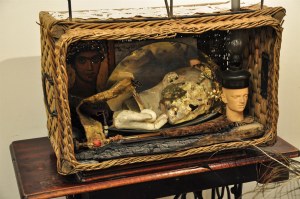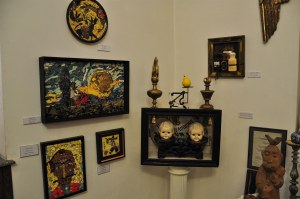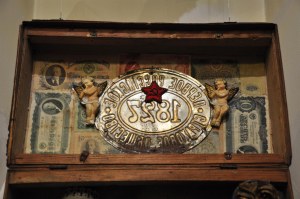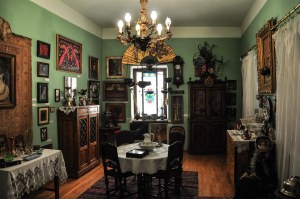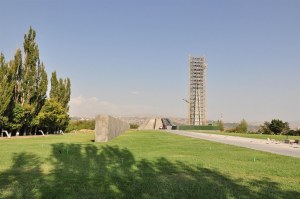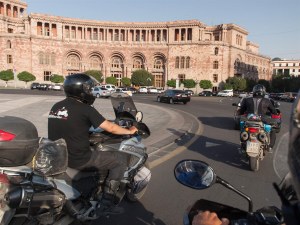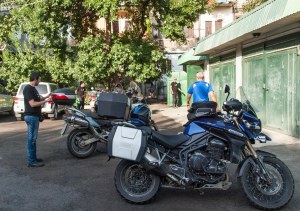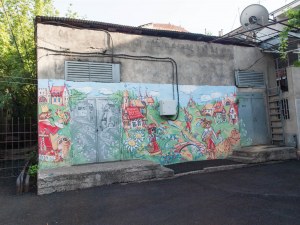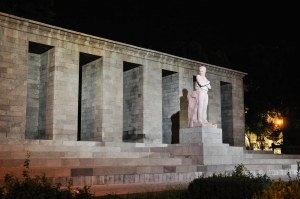One more glance in Yerevan and in the outskirts of
This day is more relaxed. We just wanted to regulate the issue of visas for Nagorno-Karabakh and visit the Garni and the Monastery Geghard. Early in the morning we were at the embassy of Nagorno. The name -in any probability- comes from the Russian word «Nagorno» meaning "mountain" and the Kara-bakh, the words «kara» = black in Turkish and «bakh» which means "garden" in Persian. The strange here is that it is unknown how was this combination made!
Nagorno-Karabakh was an autonomous administrative region of the former Soviet Union, which belonged to the Socialist Republic of Azerbaijan. Today continues to be a "de facto" autonomous republic in the South Caucasus, but officially is part of the Republic of Azerbaijan, although the majority of residents speak the Armenian language. Located about 270km west of the Azerbaijani capital Baku and very close to the border with Armenia and being essentially enclave within Azerbaijan.
The Soviet Union incorporated the predominantly Armenian region of Nagorno-Karabakh as an Autonomous Republic within the Soviet Socialist Republic of Azerbaijan in 1923. On December 10, 1991, as the USSR collapse, a referendum took place in Nagorno-Karabakh and the neighbouring Sachoumian led to declaration of independence of Azerbaijan Republic of Nagorno-Karabakh. This State entity still has not been recognized by any international organization or country, including Armenia (due to international pressure).
The area became a source of conflict between Armenia and Azerbaijan, which reached its peak with the war in Nagorno-Karabakh. The war cost the lives of thousands of people and caused waves of refugees from Karabakh to Armenia and Azerbaijan and a small portion of those in Western countries. Since the ceasefire agreed in 1994, most of Nagorno Karabakh and several regions of Azerbaijan around it (approximately 14% of Azerbaijan's territory) remain under the control of Armenian separatists in Nagorno-Karabakh. Since then, the two sides made peace talks mediated by the OSCE Minsk Group.
To visit the state must issue a visa, the cost of which is 3000 Dram, near 5,5 €. The process is simple: fill an application which is purchased from the embassy, plus a photo which is necessary. Within half an hour -at 11am- we finished and informed that the visa will be ready the same day, at 3-4pm. Under the conditions the program has as follows: first a visit to the archaeological site Garni and after that to the monastery Geghand. All that until 3pm, when we must return to the Embassy, to receive our passports. After that we will see what we’ll do...
Departen then for Garni which is about 30km from the capital. The road is relatively good in terms of landscape but with moderate asphalt condition. In many places along the road were holes and grooves, so it needed enough attention. Soon we reached the entrance of the site (entry fee 2,5 € and 0,4 € parking), where a guy in uniform, large hat and a mini cash register, plays the role of a valet.
The most important exhibit of the site is the Temple of Mithras, which in antiquity was the god of sun. The temple was built in the 2nd half of the 1st century AC and is unique in its kind, not only for Armenia but also for the wider region. It is built with Roman architecture style "kiosk", featuring ie, columns around. To the north of the church, approaching the main entrance through some stairs, at the end of it (left and right) the Atlanteans was shown, kneeling at one foot and looking one to the east and the other to the west. At the same time with us, a school with younger students is visiting the site giving us smiling poses. Just a lift of the camera and they are posing to the lens... From the same place you can enjoy the views of the gorge of Garni, which is accessible via a dirt road. We would love to go but because of time pressure we're just happy to take some photos from above.
Our next destination is the Monastery of Geghard. As we approached, we got into a spectacular gorge with steep rocks and some vegetation. On the way we met several students, one of which found amusing to through a stone to me which hit me on the chest. It was a small one but hurt enough... Just a few meters below, popped up in front of us the monastery. Here things were more relaxed as we dropped anchor free in the parking lot and went up to the monastery only covering a few meters on foot. The monastery which is surrounded by walls is the oldest in the country and is characterized by the presence of caves -as those of Cappadocia- that were once the homes and hermitages of ascetic monks in the region.
The history of the monastery of Geghard extends for over 1500 years. Founded in the 4th century and the present structure dates from the 13th century. The most important relic is a spear that is said to be the one that pierced the side of Christ while he was on the cross. Unfortunately now is kept in a museum and not in the monastery. The church of Geghard is the central attraction and features the typical architecture of Armenian monasteries, with simple interior, stone walls and steep conical roofs in spiers. In some places there are rooms within the rock, leading to larger rooms or small spaces, like cells.
We were looking around for some time, as much as needed in order to be at the embassy of Nagorno-Karabakh at 3pm. So it happened ... At 3:30pm we got the visas in our hands. The employees, stamps our passports, but they give us a group visa in a different document, so that we will not have a problem if we ever want to go to Azerbaijan. We are given two copies of the document, one of which should be left at the customs post when leaving the state.
After a short deliberation we decided to first have a look at the Parajanov museum (700 Dram (~ 2.70 €) entry and other 700 Dram for photos) and then head to the Armenian Genocide Monument located in a prominent position on a hilltop, which is visible from every point of the city. The Sergi Parajanov was born in 1924 by Armenian parents in Tbilisi, Georgia. He is considered to be one of the most brilliant and original filmmakers of the 20th century and he is the creator of the famous project "The Colour of Pomegranates". Despite his international fame, his great recognition, and also the assessment of the international film community who repeatedly awarded him, Parajanov was imprisoned by the communist regime for surreal fantasy filmmaking and the language he used.
In the isolation of prison, under the most appalling conditions, he realized that in order not to go crazy he had to deal with painting, writing and art in general. He came out of prison with eight hundred works, one hundred novels and six screenplays that claimed to be "any confession of criminal that was whispered in his ear." In 1978 he was released as a result of worldwide protests, friends and artists requests but not allowed to work in any film production studio.
The excellent, beyond the usual artistic work of his, includes collages, ceramics, dolls, figurines and several of other compositions, many of which he made in prison. He created his own unique, inimitable beauty that was not related to any rules, made by seemingly incompatible materials - carpets, old combs, broken toys, glasses, personal items, etc.
His latest film, Ashik Kerib, a Georgian-Armenian-Azerbaijani co had limited viewance in these countries. It was a deliberate attempt of Parajanov to use art to build bridges between different cultures and one of the few examples of cooperation between the Caucasus countries in the recent years. He died in 1990 without having the time to finish his autobiographical film, "Confession". This art exhibition is worth a visit simply because of its singularity. Note that along with the ticket, they gave us information leaflet in Greek.
We left the museum and headed to the Armenian Genocide Memorial which is built on the hill Tsitsernakaberd above the city. The hill got its name from the swallows that were nesting there since ancient times and according to tradition, helped in communicating of God Vachagkn with the goddess Astgkik. Unfortunately, the memorial park is in redevelopment phase and it was not easily accessible, as it was surrounded by scaffolding.
The monument consists of a column of 44 meters symbolizing the rebirth of Armenians. A little further lifted 12 stone slabs circularly arranged and tilted forward, which show the 12 provinces of Western Armenia (which was populated mostly by Armenians) and which now belong to Turkey. Right in the centre of the circle formed by the stone slabs burnt the unquenchable flame.
A little further there is the Museum of the Armenian Genocide, where one can find 1915 factual information, documents and photos. The Museum has its own little park, where presidents, prime ministers, officials, diplomats, politicians, intellectuals, foreign actors while visiting the Monument, plants trees in memory of the victims of Genocide. With a little searching we found the trees that have been planted by the Greek politicians, K. Papoulias and A. Spiliotopoulos.
We went back to the apartment for a shower before going out again for finding food. We descend to the Republic Square, where we see a beautiful sight. A DJ plays known melodies and the floodlit fountains perfectly follow the rhythm under the eyes of many viewers of all ages...
The discovery of food proves to be difficult, as the second proposed restaurant from Alice was closed and 2-3 along our way that we liked were very crowded. We ended up in a posh one named Dolmama, near the apartment, where we ete good food, although quite expensive for the country’s data. We returned to our apartment, exhausted but excited with the beautiful capital. Tomorrow we are going to leave her behind, but in the back of our head there is a scenario of coming back again...

